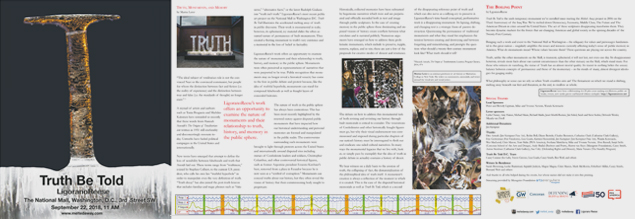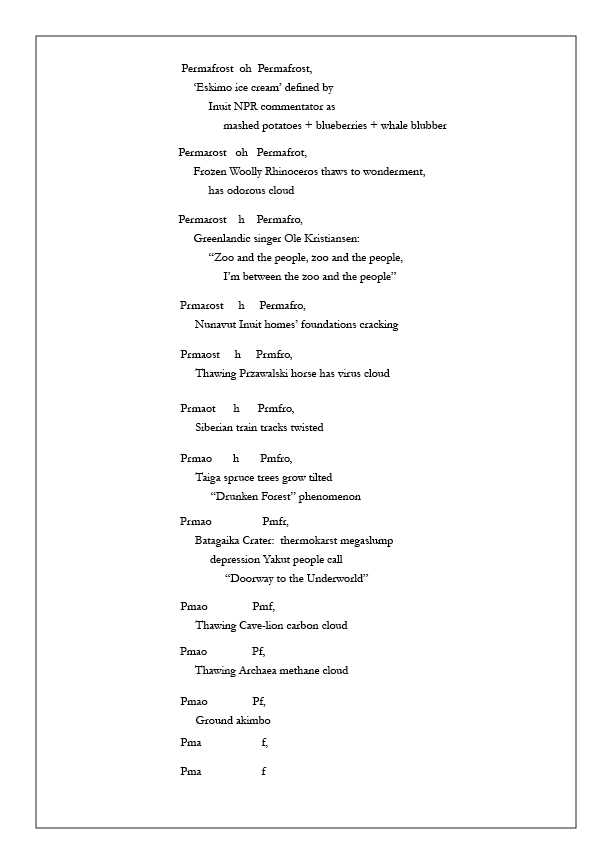
Art historian Marisa Lerer and poets Sepideh Jedeyri, Chris Mason, and Ethelbert Miller have contributed essays and poems about the diasappearance of Truth for an 4-page newspaper (a section shown here) we’re giving out to visitors on the National Mall and Truth Be Told associated events at Busboys and Poets and the Corcoran School of the Arts and Design GW.
Truth, Monuments, and Memory
Marisa Lerer
“The ideal subject of totalitarian rule is not the convinced Nazi or the convinced communist, but people for whom the distinction between fact and fiction (i.e. the reality of experience) and the distinction between true and false (i.e. the standards of thought) no longer exist.” 1
A myriad of artists and authors such as Tania Bruguera and Michiko Kakutani have reminded us recently that these words from Hannah Arendt’s The Origins of Totalitarianism written in 1951 still irrefutably and disconcertingly resonate today. Untruths have fueled political campaigns in the United States and internationally.
New terms have emerged that attempt to define the loss of sensibility between falsehoods and truth that Arendt laid out. These terms range from “truthiness,” coined by Stephen Colbert, to the current U.S. president, who calls his own lies “truthful hyperbole” in order to manipulate even the very definition of truth. “Truth decay” has also joined the post-truth lexicon that includes familiar and tragic phrases such as “fake news,” “alternative facts,” or the latest Rudolph Giuliani-ism “truth isn’t truth.” LigoranoReese’s most recent public art project on the National Mall in Washington D.C. Truth Be Told illustrates the accelerated melting away of truth in public discourse. Their work is monumental in scale; however, its ephemeral, icy material elides the often assumed nature of permanence of built monuments. They created a fleeting monument to truth’s very existence and a memorial to the loss of belief in factuality.
LigoranoReese’s work offers an opportunity to examine the nature of monuments and their relationship to truth, history, and memory in the public sphere. Monuments were often perceived as representations of narratives that were purported to be true. Public recognition that monuments may no longer reveal a historical veracity have come to the fore in public debate and protest because, like the idea of truthful hyperbole, monuments can stand for composed falsehoods as well as fraught layers of concealed histories.
The nature of truth in the public sphere has always been contentious. This has been most recently highlighted by the renewed outcry against disputed public monuments that have impacted how our historical understanding and personal memories are formed and manipulated in the public realm. The controversies surrounding such monuments were brought to light through protests across the United States and internationally around disputed sites including statues of Confederate leaders and soldiers, Christopher Columbus, and other controversial historical figures, such as former Argentine president Ernesto Kirchner’s bust, removed from a plaza in Ecuador because he is now seen as a “symbol of corruption.” Monuments can conceal truths about our history, but they often reveal the vision of history that their commissioning body sought to perpetuate.
Historically, collected memories have been subsumed by hegemonic narratives which were and are perpetuated and officially recorded both in text and image through public sculptures. In the case of creating memory in the public sphere these dominating and imposed visions of history create conflicts between what circulates and is narrated publicly. Numerous arguments have emerged on how to address these problematic monuments, which include to preserve, topple, remove, replace, and re-site; these are just a few of the proposals for creative modes of dissent and resistance. The debate on how to address this monumental task of both revising and revisiting our history through built memorials is critical to consider. The venerations of Confederates and other historically fraught figures must go, but why their visual endorsement was commissioned and imposed during particular chapters of our nation’s history must be interrogated to flesh out and eradicate one-sided cultural narratives. In many ways the monumental legacies that we live with, look at, or simply pass by exemplify that the idea of truth in public debate in actuality contains a history of deceit.
We bear witness on a daily basis to the erosion of truth, the collapsing of fact, the dematerialization of the philosophical idea of truth itself. A monument’s creation is always a reflection of the moment in which it is created. This is the case of the disputed historical memorials as well as Truth Be Told, which is a record of the disappearing reference point of truth and which can also serve as a rallying cry to preserve it. LigoranoReese’s time-based conceptual, performative work is a disappearing monument. Its lapsing, shifting, and changing text is a strategic form of passive destruction. Questioning the permanence of traditional monuments and what they stand for emphasizes the tension between creating and destroying and between forgetting and remembering, and prompts the question: What should a twenty-first century monument look like? What truth should it tell?
1. Hananh Arendt, The Origins of Totalitarianism (London: Penguin Classics, 2014), 474↩
Marisa Lerer is an assistant professor of art history at Manhattan College in New York. She writes on monuments, memorials, and issues around the visual arts and social justice.
What do we mean by “Truth Disappearing?”
for Charles Bernstein
Sepideh Jedeyri
In my homeland Iran, there is no truth but a partial truth. The main part; the most important and serious part is the one that is never told or always censored. Let me say that in my homeland, people go to prison for telling the truth. A recent example was an activist1 on the Left who went to prison for revealing a TV serial sponsor’s financial corruption.2 Thus, it seems that in my homeland, the world is upside down: Not the truthteller, but the slanter has the ace in their hand. And it is not the whole story. While we migrate to escape from that absolute untruthiness, we face it again in an outwardly free country – i.e., the very country you and I live.
You might be surprised but let me tell you my own story. I am a freelance writer and translator working for a couple of Iranian news websites based in U.S. that must normally follow the U.S. rules. But while calling it “editing” and “summarizing,” they garble and even censor texts written or translated by people who share viewpoints against the warlike policies and imposition of the economic sanctions on countries such as Iran, or those whose viewpoints are in support of Palestine.
An example is my translation of a text about some of Hannah Arendt’s radical stands against Zionism. They modified the translation to a feckless text in which even “Zionism Reconsidered”, the title of an Arendt’s article, turned into “Zionism Reviewed”!
Another example is my translation of a university professor’s analysis of the efforts at regime change (by U.S. and by others). Under the pretext of summarizing, they omitted the preface that was the only part of the text in which the author directly pointed out Trump’s, Bolton’s and Pompeo’s advocacy of warlike policies against Iran.
Considering that I am not the only person to whom this happens, some may understand the reason why it happens: The journals scare! They are afraid to publish the whole truth because they know that in such a case, their budget would be cut.
And this is still not the whole story! A few months ago, a brave Iranian woman took off her headscarf and turned it into a flag in a street called “Enqilab”3 in central Tehran. Being known as “the Girl of Revolution Street” ever since, she did this to protest compulsory Hijab in Iran. A few days later, with a flag made by a headscarf, I joined the Women’s March in Washington DC. And hours later, someone from a U.S. mainstream media outlet called to interview me about the reason I did so. Through the entire hour-long interview, I steadfastly insisted on the fact that my protest was – the same as the other women’s- mainly against Trump’s discriminative policies, but also, I wanted to be the voice of “the Girl of Revolution Street.” However, that same media source which is generally considered to be a liberal one, published just two paragraphs in which there was nothing reported of what I said against or even about Trump.
Now, I want to ask you, or maybe you ask me that when we talk about “Truth Disappearing,” which one do we exactly mean?
The one that happens in the countries ruled by dictatorships, such as my homeland (one of Mr. Trump’s favorite subjects); or the one that happens in a country that claims to present democracy to other countries especially those subject to regime change? (That would be the favorite subject for dictators like the rulers in Iran.)
Perhaps, just we are the problem; we, who should not know the truth and are used to not knowing it; we, who are “still reviewing the night and the day, the ‘always.'”4
1. Nader Fatourehchi, an Iranian left activist, translator and journalist.↩
2. Mohammad Emami, a sponsor of one of the most popular Iranian TV serials, Shahrzad.↩
3. In Persian, it means “Revolution.”↩
4. A line of a poem by Ahmad Shamlou, one of the most prominent contemporary Iranian poets.↩
Sepideh Jodeyri is an exiled Iranian poet with ten published books. She is also the founder of Khorshid (Iranian Women’s Poetry Prize).
TRUTH
E. Ethelbert Miller
After the truth melts will a hard rain fall?
What comes after the crying, the countless tears and the flooding of America?
If this is the beginning of another Ice Age what will become of us?
What becomes of history when truth disappears into air?
How much coldness can we continue to hold in our hands?
I pray that after the melting comes a hot hunger for freedom.
Ethelbert Miller is a writer and literary activist. If God Invented Baseball (2018) is his most recent book.
Permafrost oh Permafrost
(for Nora Ligorano and Marshall Reese)
Chris Mason
A page preview shown here. Download the pdf to view the entire piece.

Chris Mason is the author of Hum Who Hiccup (Narrow House) and Where To From Out (Furniture). He is in 3 bands: The Tinklers, Old Songs, and Coocoo Rockin Time.
The Boiling Point
LigoranoReese
Truth Be Told is the sixth temporary monument we’ve installed since starting the Melted Away project in 2006 on the Third Anniversary of the Iraq War. We’ve melted down Democracy, Economy, Middle Class, The Future and The American Dream in cities around the United States. The act of these sculptures disappearing transforms them. They become dynamic markers for the forces that are changing American and global society in the opening decades of the Twenty-First Century.
Bringing such a work and event to the National Mall in Washington – the reliquary for values and personages fundamental to this great nation – singularly amplifies the issues and tensions currently affecting today’s sense of public memory in America. What do monuments mean? Whose values become them? These questions are playing out across the country.
Truth, unlike the other monuments on the Mall, is transient, ephemeral; it will not last, not even one day. Its disappearance however, reveals more facts about our current circumstances than the other statuary on the Mall, which stand mute. For those who witness its vanishing, the statue of Truth has an almost mortal quality. Its transit to nothing belies the uneasy balance between concepts of permanence and those of the momentary – in the minds of many, almost divergent ideologies for gauging reality.
What philosophy or sense can we rely on when Truth crumbles into air? The firmament on which we stand is shifting, melting away beneath our feet and threatens, in the end, to swallow us whole.
LigoranoReese have been collaborating for 20 plus years making installations, public art works, events, new media pieces and limited edition multiples. http://ligoranoreese.net